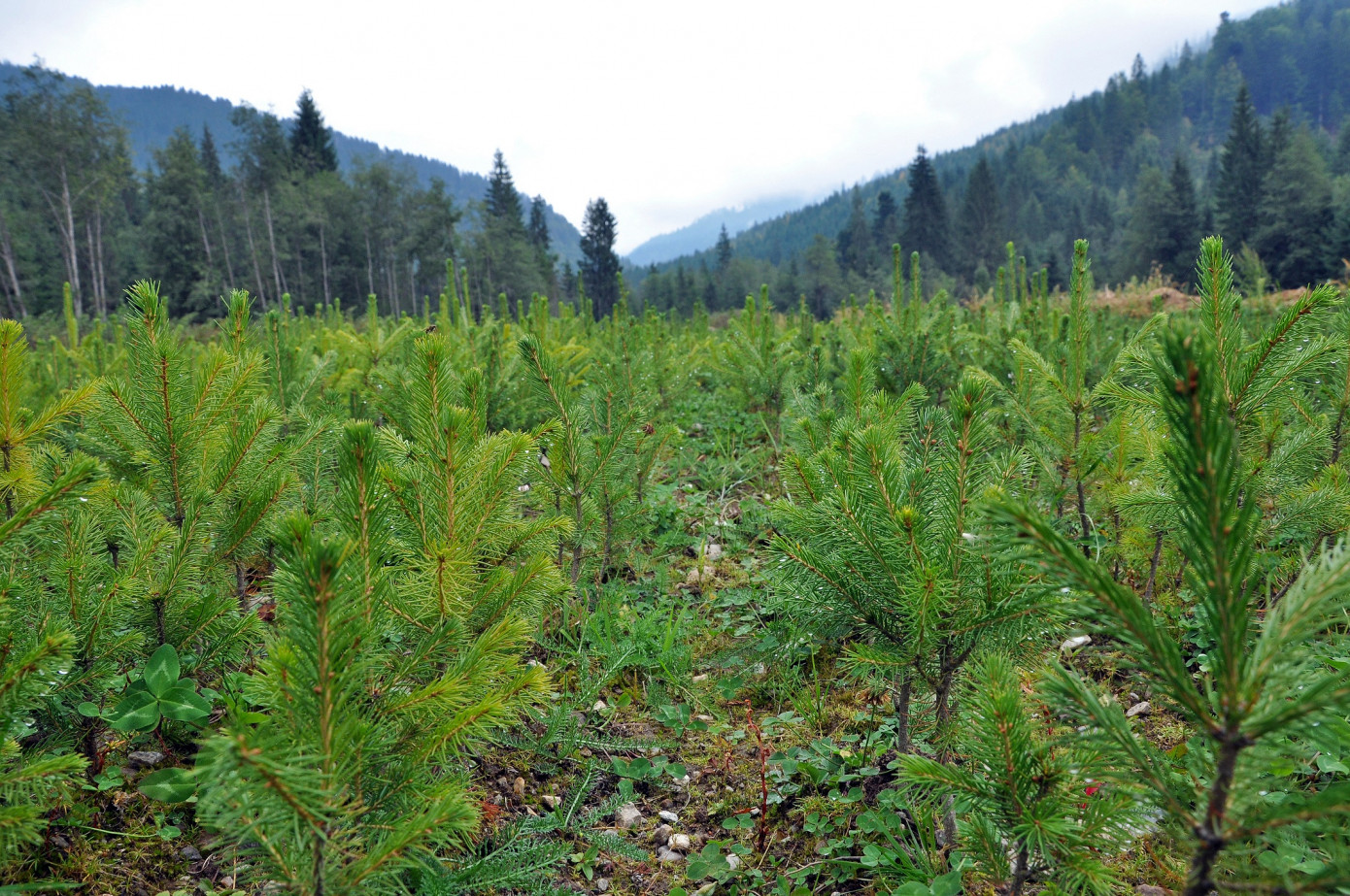The first forest lease agreement was signed by the Russian Titan Group in 1999 with the Karpogorsk Forestry in Arkhangelsk region of Russia. The plot area amounted to 236.6 thousand ha, and the annual cutting volume was 243.2 thousand m3 of wood. The main problem that had to be faced then was obsolete forest inventory documents. The forest inventory documents were drawn 25 years ago in the most forest sites. During that time, forests have changed a lot. It was not easy to plan economic activities and determine sustainable annual use.
In Russia a significant part of high conservation value forests is not allocated, and economic activity in such areas is not regulated by law. The most striking example is intact forest territories. Companies have to single out such forests on their own, determine their borders, take part of the forests under protection, refusing to use them. In some cases, companies voluntarily reduce the annual amount of use, but at the same time continue to pay rent to the state in full.
First FSC certification
Preparations for the first certification showed that the practice established by the Titan Group for logging, construction of forest roads, organization of shift camps and labor protection for workers, although fully consistent with the law, was far from the best practices of European companies that have already passed certification according to FSC standards. It was necessary to start almost from scratch: to explain to all employees of the company the very essence of certification. The company's preparation for certification was attended by experts on the allocation of high conservation value forests, specialists on biodiversity conservation, and training seminars were held. Without the involvement of consultants and experts, certification was simply impossible at that time.
The first audit was conducted by Rainforest Alliance and NEPCon. All subsequent forest management and supply chain audits and certifications were conducted by NEPCon. Despite the long experience of cooperation, NEPCon does not make indulgence for the enterprises of the group. Sometimes, according to the results of audits, disagreements arise on certain issues, and the parties reach an appeal. The first forest management certificates according to FSC standards in 2005 were received by the Ust-Pokshengsky and Shalakushales Forestries, which are parts of the Titan Group. The area of certified forest sites then amounted to 510 thousand ha.
All units of the Titan Group passed certification at one time. But in order to achieve this, a preliminary audit was carried out, which made it possible to understand the main inconsistencies to the FSC standard and outline ways to address them. If you look at the reports of audit companies on the first basic assessments, you understand how much is needed to be done to fully comply with the requirements of the standard. This applies to all aspects of the activity, there were inconsistencies in almost all the criteria of the standard.
Since then, the Titan Group has gained considerable experience in forest management certification, and all its units are prepared for certification. But even now, when a new certification begins, an internal audit is carried out in the group, followed by a preliminary audit of forest management. The main assessment begins only after all inconsistencies with the requirements of the forest management standard have been eliminated. The whole process of preparing an enterprise from the moment a decision is made on certification to obtaining a certificate takes from 6 months to a year. The bulk of the work related to meeting the requirements of the standard is carried out by the specialists of the group. But even now, when expanding the scope of the certificate or with a new certification, consultants are involved and training seminars are held. As of early March 2020, the Titan Group leases 64 forest plots with a total area of 5.48 million ha. The group holds 9 forest management certificates, and the area of certified forests is 3.47 million ha.
Image: About 17 million seedlings of pine and spruce were planted by the Titan Group at logging sites over the past 11 years only
Indigenous rights and community relations
The third and fourth principles of the FSC determine the practice of the relationship of the enterprise with indigenous peoples and local communities in the area of the enterprise. The company should identify all groups of indigenous peoples, local communities traditionally living in forest areas and whose lifestyle is traditionally associated with the forest. It is needed to identify places of particular cultural, environmental, economic and religious value for indigenous peoples. Together with communities company has to determine the economic use of such territories. The Titan Group regularly consults with the local population. Within the framework of such consultations, for example, areas of forest, traditionally used as winter deer pastures, were identified in the Pinezhsky District. The group signed an agreement with the Nanets community Kanin on the complete rejection of cutting of stands on an area of 10.8 thousand hectares. In another 13.5 thousand hectares of forest the group carries out economic activities only by agreement with the community . This is one example of the use and protection of places of interest to indigenous peoples. At the same time, the group constantly finances projects for the preservation of cultural heritage in the territories where its units are present.
The group’s logging enterprises mainly employ residents of settlements located in forest areas or near their borders. They have an advantage in employment. And this is the best form of involving local communities in decision-making. They participate in public hearings on planned economic activities in forest areas, which are held every five years. This allows you to receive real-time feedback. The group also holds public hearings on specific but key issues for both the company and the public. For example, the hearings discussed the organization of the Dvina-Pinezhsky Reserve, its borders and the regime. Continuous information transparency and a disclosure plan are required. The Titan Group annually publishes the “Plan of Economic Activities in the Forest Area” and the “Report on Economic Activities”. These documents are transmitted to local administrations, public and school libraries, posted on the group’s website.
High conservation value forests
High conservation value forests are a very broad concept. These include forest areas that have the most important environment-forming functions that are important for the local population, habitats of rare species of animals and plants, and many others. Therefore, the Titan Group engages a wide range of specialists in consultations regarding these territories.
Image: FSC Principle 6: The forestry system should ensure the conservation of biological diversity. The Titan Group roadmap provides a plan for the conservation of about 30% of intact forests in 24 leased forest areas until 2028. In these forests, there are many rare birds and animals, such as, for example, the Great Gray Owl, which is included in the IUCN Red List.
Usually it starts with a request for information on the availability of high conservation value in the certified territory. Further consultations and their forms depend on the complexity of the issue. This can be consultations in the mode of video conferencing, personal meetings, seminars, field trips to forest areas of high conservation value, joint expeditions. The lease of the group includes all categories of forests of high conservation value. In some forest areas, such forests occupy up to 50% of the area. Among the rare ecosystems, it is worth highlighting old-age lichen pine trees. Once they was typical plantings for the Arkhangelsk region. But these forests were also the most accessible for exploitation. Currently, they are on the verge of extinction, in certified forests they occupy only 0.16% of the area. Another category of high conservation value forests is intact forest landscapes . At the same time they are exploitable forests, and in the conditions of pioneer development, it is they who are primarily subject to exploitation for the purpose of logging. As a result, in the southern regions of the Arkhangelsk region, very small forest areas were preserved that were not affected by economic activity.
In Russia, intact forest landscapes are not protected by current environmental and forest legislation. In order to ensure their protection, the Titan Group, Arkhangelsk PPM and Lesozavod-25 in 2018 signed an Agreement with the non-governmental environmental organizations on the creation of the Dvinsko-Pinezhsky Nature Reserve. The consolidated contribution of enterprises amounted to more than 170 thousand ha of intact forests. In 2019, the Titan Group signed an agreement with WWF, with the participation of FSC Russia, to preserve the IFL throughout the territory under its control and in its roadmap. The agreement and the roadmap were developed until 2028, provide for the conservation of about 30% of intact forests in 24 leased forest landscapes. In addition, the roadmap provides for a number of measures aimed at reducing the industrial load on intact forest territories by intensifying the use and reproduction of forests in already developed territories.
Principle 6 of the FSC standard defines rules for reducing environmental impact. Logging operations significantly affect forest soils, especially when logging logs. Forestry equipment moving around cutting areas compacts the soil and destroys its upper layers. The Group “Titan” has developed instructions to minimize the negative impact on the soil during logging activities. The instruction prescribes measures to protect forest soils during harvesting. Group companies monitor soil damage. In the event of revealing severe damage that negatively affects their fertility, compensation measures are carried out, including mechanical tillage. In the future, such sites are examined with a frequency of five years.
Practical Forest Certification Preparation Tips
1. How to prepare for forest certification
Sustainable forest management is a balance of economy, ecology and social interests. It is important to make the right calculation from the very beginning. First, forest management must be sustainable and economically viable. Secondly, it should be organized in such a way that the subsequent resolution of environmental issues does not become an economic problem for the company. Thirdly, forest management should bring social benefits to the local population indefinitely.
When preparing for certification, you need to pay attention to everything: the working conditions of workers, safety measures, the calculation of the use of forests, compliance with Russian and international laws, the conservation of forest biodiversity, the interests of the local population, and the transparency of the company. In the certification standard, among the evaluation criteria there are no more or less important, they are all equal.
2. Indigenous people interests
Relations with the local communities must be formed on the basis of a completely equal partnership in forest management. At the same time, the interests of your company and the interests of the local population regarding forests often may not coincide. You need to find solutions in which the interests of the company become the interests of the local population.
3. Relations with stakeholders
Information transparency is the main thing. You must always openly and reasonably declare your interests, offer several options for solving possible problems. It is important to maintain consistency in the implementation of all agreements reached. We need to find mutually acceptable solutions, they will become the basis for the development of relations with stakeholders.
4. Organization of protection of high-value forests
The main principle is that all forests have natural value, which increases with the development of the territory. First of all, you need to protect forest ecosystems that are rare in nature and that carry out environment-forming functions. Keep in mind that a complete ban on the economic use of forests of high conservation value sometimes does not guarantee their conservation. In some cases, to preserve their basic natural values, it is enough to change the approach to the exploitation of these forests.
